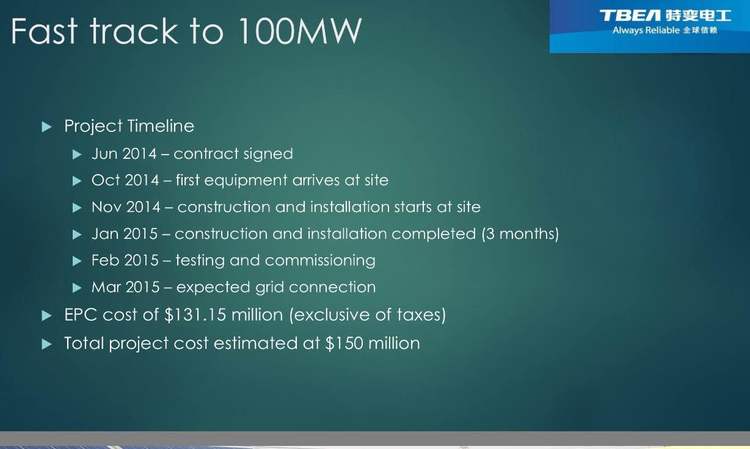
The Sunday Mail

ON May 15, 2016, Germany recorded an incredible feat: the country’s power demand of 45,8 gigawatts was almost totally met by supplies from renewable energy sources, which generated more than 45,5 gigawatts on the day.
To put this into perspective, this is roughly half the amount of power that was generated in all the 48 countries in Sub-Saharan Africa in 2012.

Quaid-e-Azam Solar Power Park. Insert – the timeline that the contractor management to meet for the solar project
Ordinarily, Germany – which boasts a US$3,7 trillion economy – would be expected to have the financial wherewithal to undertake these projects, but it is doesn’t have an urgent compulsion – outside the European Union agreement to promote clean energy – to be aggressively pursuing the same.
Incredibly, Zimbabwe – which must have all the motivation to tap into alternative sources of energy, especially in the wake of increased imports of expensive power from the region – has elected to be slothful and careless in the manner it implements proposed projects.
But this obviously is not by design.
The effect of 16-year-old sanctions, which helped breed bestial instincts such as greed and avarice – traits that peaked during the hyperinflationary era – are taking a toll on the country’s local development agenda.
Projects that are ideally supposed to be for the greater good are seemingly being appropriated for narrow self-enriching interests.
The continued stalling in implementing the country’s solar projects, which by now could have been contributing more than 300MW to the national grid – helping to substitute expensive power imports – is perhaps one of the clearest signs yet of the damaging effects of greed, where the motivation to curve a fortune from national projects end up tampering with processes to implement the same.
Zimbabwe and Pakistan embarked on similar 100MW solar projects around the same time – 2013.
However, the scope of the projects later changed, with the former opting to implement three projects that are supposed generate 100MW each, while the latter broadened its project to a 1 000MW solar venture.
Since then, the two countries have pursued separate paths that have resulted in contrasting fortunes.
The Pakistan solar project, which was named in honour of Quaid-e-Azam, the nation’s founder, has been transformed from a concept paper in 2013 to a fully-functional project that was commissioned in May 2015.
It took three months to install the plant.
To be exact, after 2013 international tenders were called for the first 100MW plant and 12 international companies were pre-qualified.
After choosing the winning bid, the contract was signed in June 2014. The equipment for the project started to arrive on the site in October 2014. By the beginning of last year, construction and installation had begun.
By May 2015, 100MW were being fed into the grid.
Interestingly, the total cost of the project was US$150 million.
It doesn’t end there.
The plant is being expanded in line with the original undertaking to increase capacity to 1 000MW by year end.
More than 320 000 families will benefit directly from the project by the end of 2016.
Yet Zimbabwe will still be importing power at a punitive cost of more than USc18 per kilowatt hour.
There is obviously need for a lot of soul searching.
Since 2013, the country’s local effort to tap into solar power has lurched from one tragi-comic turn to the other.
Initially, just as Pakistan, the venture, slated for Matabeleland South, was supposed to generate 100MW.
CJC was adjudged to have been the winner in January 2014.
Later, the State Procurement Board indicated that the tender had been flouted and companies were again invited to submit tenders before October 28, 2014.
Notably, the decision that was taken by the SPB to opt for a restrictive tendering process, where the board cherry-picked companies to bid for the project rather than an open tendering process that could have attracted capable and efficient companies, was questioned.
Mid-way through the process, the SPB changed the rules of the game and indicated that since the scope of the project was broadened.
It had to rope in the other companies that had ironically been the losing bidders during the first tender.
It is a treasonous tragedy.
It might not be convenient to dwell on the identity of the selected bidders, some of whom have been subject to investigations on various allegations, but to interrogate the price that has been quoted for the projects, which has since risen to more than US$200 million – US$50 million more than the cost of the Pakistan project.
This will definitely have an impact on the feed-in prices of power to the local grid.
Already, there is controversy over the real tariffs that are being quoted for power generated from the Quaid-e-Azam Solar Park.
While it is publicly stated that the said power is being charged for USc14, there are those who claim that there is an agreement between the company and the National Transmission and Dispatch Company of Pakistan to buy power at USc24 per unit, which is expected to drop to USc17 after seven years.
These prices are considered to be relatively higher than the USc0,7 for hydro, USc11 for petroleum fuel and USc12 for gas.
One can only speculate on the tariff that local consumers will pay for a project whose costs have seemingly been inflated to US$200 million.But, true to our form, we are still talking the talk.
It might take another two years before anything materialises from the projects.
It’s time we walk the talk.
Feedback: [email protected]



